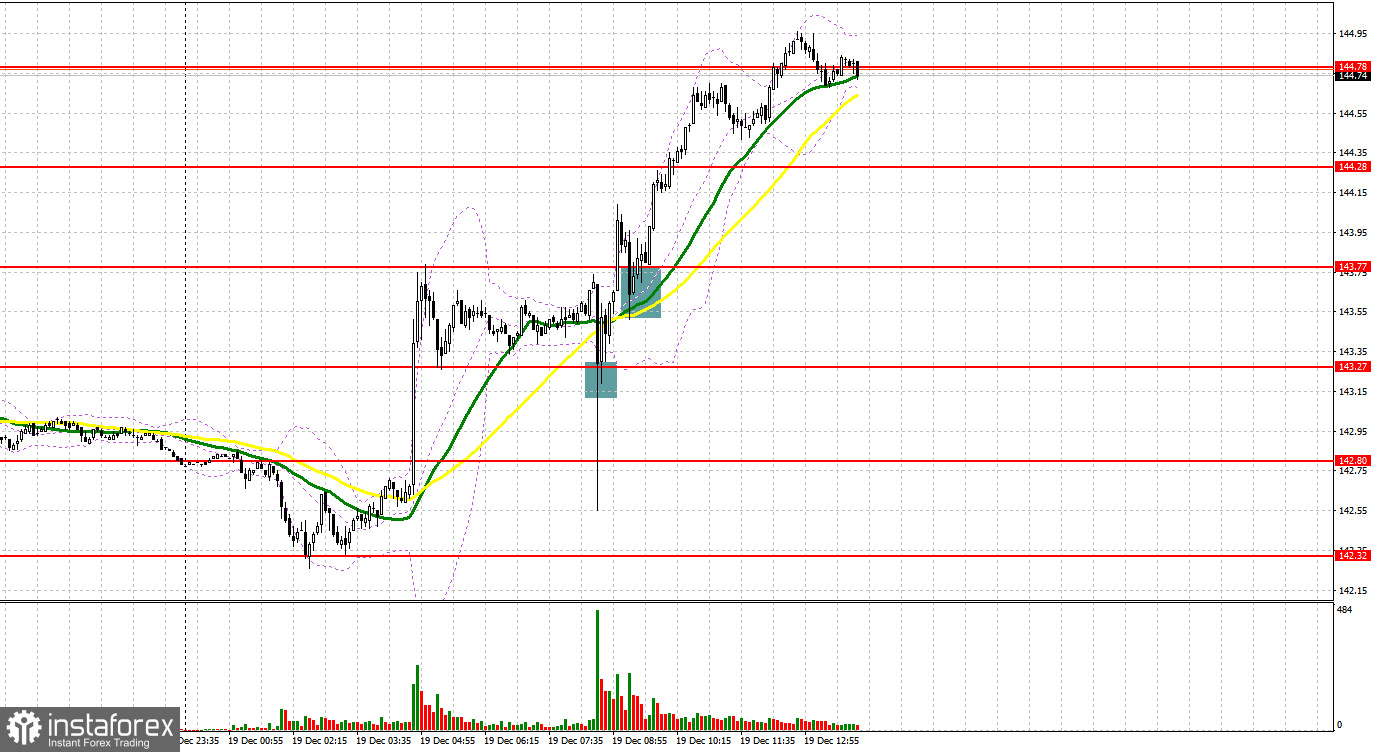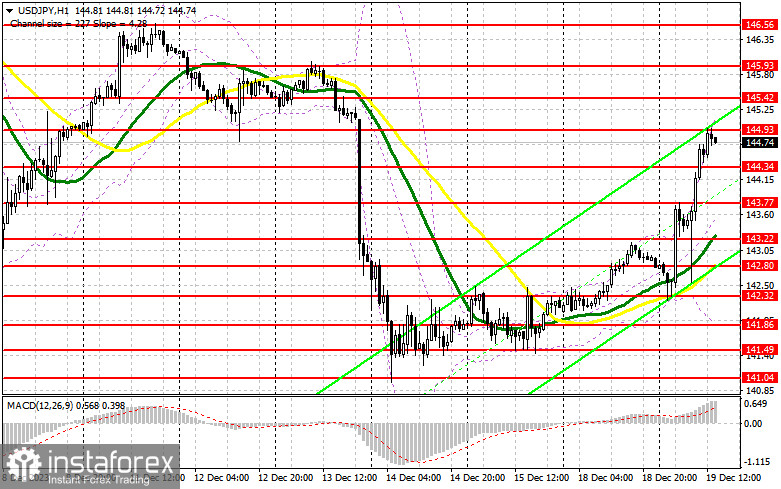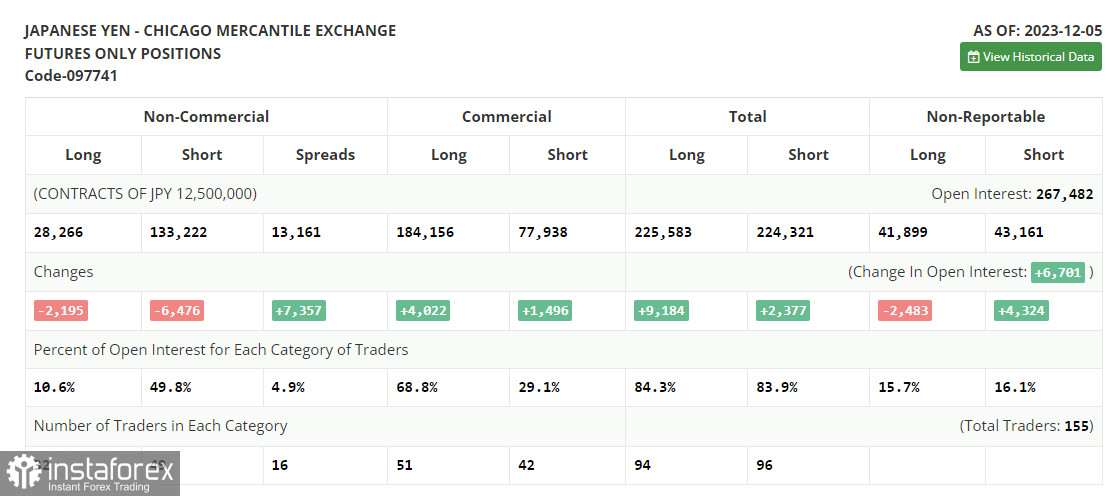In my morning forecast, I drew attention to the level of 143.27 and recommended making entry decisions based on it. Let's look at the 5-minute chart and analyze what happened there. The decline and the formation of a false breakout around 143.27 provided an excellent buy signal, resulting in the pair rising by more than 90 points. Defense at 143.77 closer to midday, with a similar false breakout, allowed re-entering the market, after which the pair moved up by about 90 points again. Considering the strong bullish market, the technical picture was revised for the second half of the day.

To open long positions on USD/JPY, the following is required:
The main reason for the yen's fall is the Bank of Japan meeting, where the regulator maintained the negative interest rate unchanged and provided no guidance on when it plans to abandon this policy. Many traders were expecting something different. We have data on the volume of building permits issued and the number of new housing starts in the US. Weak indicators will pressure the dollar, leading to a slight decline in the pair. In this case, an attempt will be made to use the nearest support at 144.34. The formation of a false breakout there will signal a buy with the aim of further growth to the resistance area of 144.93, formed by the results of the first half of the day. Breaking and retesting this range from top to bottom on the backdrop of good US statistics will provide another entry point for buying, similar to what I discussed earlier, capable of pushing the pair towards an update at 145.42. The ultimate target will be the area around 145.93, where I would take profits. In the scenario of a decline in USD/JPY and the absence of activity at 144.34 from buyers in the second half of the day, pressure on the pair will increase. Still, a more significant decline is unlikely to be expected. In that case, I will attempt to enter around 143.77. Only a false breakout will signal the opening of long positions. I plan to buy USD/JPY immediately on a rebound only from 143.22, with a 30-35 point correction target within the day.
To open short positions on USD/JPY, the following is required:
Sellers are leaving the market, and it's challenging to say where new major players might appear. Therefore, be very careful with sales today. I don't plan to go against such a bullish market. Only the formation of a false breakout around the new resistance at 144.93 will provide a sell signal capable of pushing USD/JPY down to the nearest support at 144.34, formed by the results of the first half of the day. Breaking and retesting this range from bottom to top will deal a more serious blow to buyer positions, leading to the clearing of stop orders and opening the path to 143.77, where I expect the involvement of major buyers. A more distant target will be the area around 143.22, where I would take profits. In the scenario of USD/JPY growth and the absence of activity at 144.93, buyers will likely continue to control the market. In that case, postponing sales until testing the next resistance at 145.42 is best. If there is no downward movement, I will sell USD/JPY immediately on a rebound from 145.93, but I am only expecting a pair correction down by 30-35 points within the day.

In the COT report (Commitment of Traders) for December 5, there was a decrease in both long and short positions. Recent statements by the Bank of Japan representatives that super-soft policies and negative interest rates will no longer be needed next year led to a sharp rise in the yen and a weakening of the dollar's positions. However, after the recent largest sell-off of USD/JPY, traders quickly bought the decline, compensating for 2/3 of the drop. A lot will depend on the Federal Reserve's decision on interest rates this week. If the policy remains tough, it is clear that the problems for the Japanese yen will increase, and we will see further pair growth. The last COT report stated that long non-commercial positions fell by 2,195 to the level of 28,266, while short non-commercial positions decreased by 6,476 to the level of 133,222. As a result, the spread between long and short positions increased by 7,357.

Indicator signals:
Moving averages:
Trading is above the 30 and 50-day moving averages, indicating further dollar growth.
Note: The author considers the period and prices of moving averages on the hourly chart H1, which differs from the general definition of classical daily moving averages on the daily chart D1.
Bollinger Bands:
In the event of a decline, the lower boundary of the indicator, around 141.85, will act as support.
Indicator Descriptions:
- Moving Average (MA) determines the current trend by smoothing volatility and noise. Period 50. Marked on the chart in yellow.
- Moving Average (MA) determines the current trend by smoothing volatility and noise. Period 30. Marked on the chart in green.
- MACD (Moving Average Convergence/Divergence) indicator: Fast EMA period 12, Slow EMA period 26, SMA period 9.
- Bollinger Bands: Period 20.
- Non-commercial traders are speculators such as individual traders, hedge funds, and large institutions using the futures market for speculative purposes and meeting specific requirements.
- Long non-commercial positions represent the total long open position of non-commercial traders.
- Short non-commercial positions represent the total short open positions of non-commercial traders.
- The net non-commercial position is the difference between non-commercial traders' short and long positions.
 English
English 
 Русский
Русский Bahasa Indonesia
Bahasa Indonesia Bahasa Malay
Bahasa Malay ไทย
ไทย Español
Español Deutsch
Deutsch Български
Български Français
Français Tiếng Việt
Tiếng Việt 中文
中文 বাংলা
বাংলা हिन्दी
हिन्दी Čeština
Čeština Українська
Українська Română
Română

